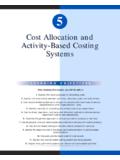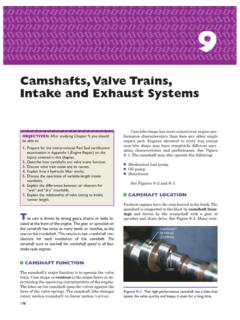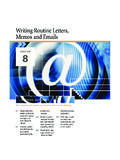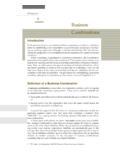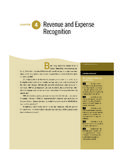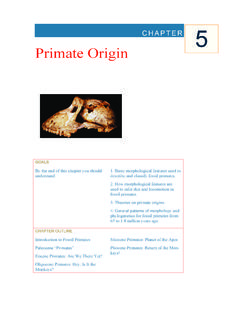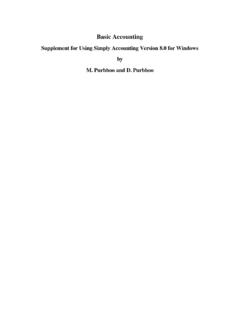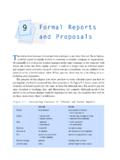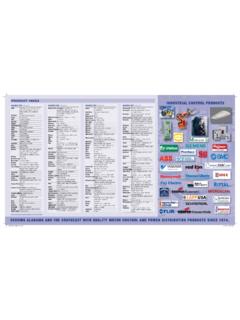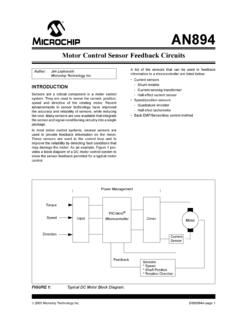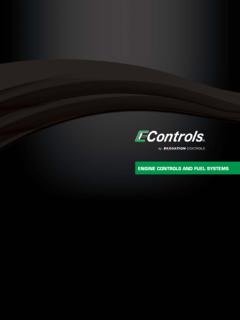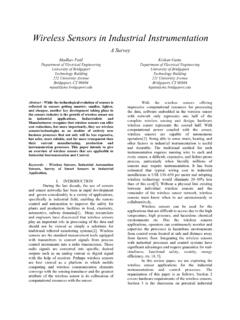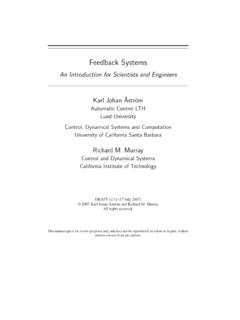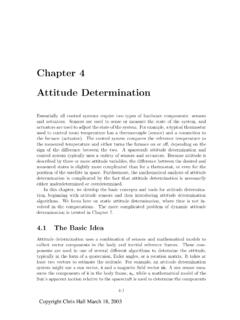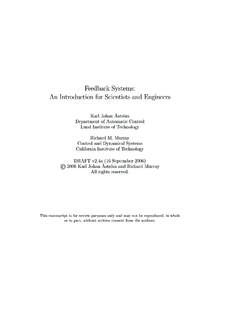Transcription of Computers and Sensors— Operation,Diagnosis, …
1 59125 COMPUTER CONTROLM odern automotive control systems consist of a net-work of electronic sensors, actuators, and computermodules designed to regulate the powertrain and ve-hicle support systems. The powertrain controlmodule (PCM)is the heart of this system . It coordi-nates engine and transmission operation, processesdata, maintains communications, and makes the con-trol decisions needed to keep the vehicle Computers use voltage to send and re-ceive information. Voltage is electrical pressure anddoes not flow through circuits, but voltage can be usedas a signal. A computer converts input information ordata into voltage signal combinations that representnumber combinations.
2 The number combinations canrepresent a variety of information temperature,speed, or even words and letters. A computerprocesses the input voltage signals it receives by com-puting what they represent, and then delivering thedata in computed or processed FOUR BASIC COMPUTER FUNCTIONSThe operation of every computer can be divided intofour basic functions. See Figure 25 1. Input Processing Storage OutputNOTE:Standardized Emissions TerminologyIn the early 1990s, the Society of Automotive Engineersdeveloped a common list of terms (SAE J1930) for emis-sion related parts, , ignition, fuel delivery and emis-sion control components. These terms, by law, havebeen used in all Canadian and automotive serviceand training publications since January 1, 1995.
3 Manyautomobile manufacturers began using the new termsin 1993 when California adopted an example, the on-board computer had beenknown as a Micro-computer, a Processor, an EngineControl Assembly (ECA), or an Engine control Unit(ECU) depending on the manufacturer. The new term,standard in the industry, is Powertrain control Mod-ule (PCM).It is important to note that older publications be-fore the mid-1990s may use different terms than cur-rent and Sensors Operation, diagnosis ,and ServiceOBJECTIVES:After studying Chapter 25, you shouldbe able for the interprovincial Red Seal certificationexamination in Appendix VIII (Engine Performance)on the topics covered in this the purpose, function and operation of on-board programming differences between a PROMand an the operation and testing procedures forthrottle position, manifold absolute pressure andcoolant temperature the operation of heated and non-heatedexhaust gas oxygen adaptive basic functions are not unique to comput-ers.
4 They can be found in many noncomputer sys-tems. However, we need to know how the computerhandles these , the computer receives a voltage signal (input)from an input device. The device can be as simple asa button or a switch on an instrument panel, or asensor on an automotive engine. See Figure 25 2 fora typical type of automotive use various mechanical, electrical, andmagnetic sensors to measure factors such as vehiclespeed, engine RPM, air pressure, oxygen content ofexhaust gas, airflow, and engine coolant tempera-ture. Each sensor transmits its information in theform of voltage signals. The computer receives thesevoltage signals, but before it can use them, the sig-nals must undergo a process called input process includes amplifying voltagesignals that are too small for the computer circuitryto handle.
5 Input conditioners generally are locatedinside the computer, but a few sensors have theirown input-conditioning voltage signals received by a computer areprocessed through a series of electronic logic circuitsmaintained in its programmed instructions. Theselogic circuits change the input voltage signals, ordata, into output voltage signals or program instructions for a computer are storedin electronic memory. Some programs may requirethat certain input data be stored for later referenceor future processing. In others, output commandsmay be delayed or stored before they are transmittedto devices elsewhere in the the computer has processed the input signals,it sends voltage signals or commands to other de-vices in the system , such as system actuators.
6 An ac-tuatoris an electrical or mechanical device thatconverts electrical energy into a mechanical action,such as adjusting engine idle speed, altering suspen-sion height, or regulating fuel also can communicate with, and con-trol, each other through their output and input func-tions. This means that the output signal from onecomputer system can be the input signal for anothercomputer COMPUTERSIn a digitalcomputer, the voltage signal or process-ing function is a simple high/low, yes/no, on/off sig-nal. The digital signal voltage is limited to twovoltage levels: high voltage and low voltage. Sincethere is no stepped range of voltage or current in be-tween, a digital binary signal is a square signal is called digital because the on and offsignals are processed by the computer as the digitsor numbers 0 and 1.
7 The number system containingonly these two digits is called the number or letter from any number system orlanguage alphabet can be translated into a combina-tion of binary 0s and 1s for the digital digital computer changes the analog input sig-nals (voltage) to digital bits (binary digits) of informa-tion through an analog-to-digital (AD) convertercircuit. The binary digital number is used by the com-puter in its calculations or logic networks. Output sig-nals usually are digital signals that turn systemactuators on and digital computer can process thousands ofdigital signals per second because its circuits are592 CHAPTER 25 Figure 25 1 All computer systems perform four basicfunctions: input, processing, storage, and 25 2A potentiometer uses a movable contact tovary resistance and send an analog to switch voltage signals on and off in billionthsof a second.
8 See Figure 25 of a ComputerThe software consists of the programs and logic func-tions stored in the computer s circuitry. The hard-ware is the mechanical and electronic parts of Processing Unit (CPU)The micro-processor is the central processing unit (CPU)ofa computer. Since it performs the essential mathe-matical operations and logic decisions that make upits processing function, the CPU can be consideredthe heart of a computer. Some Computers use morethan one microprocessor, called a MemoryOther integrated-circuit(IC) devices store the computer operating pro-gram, system sensor input data, and system actu-ator output data, information necessary for ProgramsBy operating a vehicle on a dynamometer and man-ually adjusting the variable factors such as speed,load, and spark timing, it is possible to determine theoptimum output settings for the best driveability,economy, and emission control .
9 This is called Figure 25 mapping creates a three-dimensionalperformance graph that applies to a given vehicleand powertrain combination. Each combination ispermanently mapped digitally onto an IC chip calleda programmable read-only memory (PROM).This allows an automaker to use one basic computerfor all models; a unique PROM individualizes thecomputer for a particular model. Also, if a driveabil-ity problem can be resolved by a change in the pro-gram, the manufacturers can release a revisedPROM to supersede the earlier manufacturers use a single PROM thatplugs into the computer. See Figure 25 5. Other com-puters use a non-replaceable calibration module thatComputers and Sensors Operation, diagnosis , and Service593 Figure 25 3 Many electronic components are used toconstruct a typical vehicle computer.
10 Notice all of thechips, resistors, and capacitors that are used in thiscomputer. Figure 25 4 Typical ignition timing map developed fromtesting and used by the vehicle computer to provide theoptimum ignition timing for all engine speeds and 25 5A replaceable PROM used in a GeneralMotors computer. Notice that the sealed access panel hasbeen removed to gain the system PROM. If the on-board computerneeds to be changed, the replaceable type of PROM orcalibration module must be removed from the defec-tive unit and installed in the replacement original PROM was programmed to re-duce emissions, improve fuel economy and provideacceptable power. Replacing the factory PROM with an aftermarket hot PROM to increase en-gine performance often increases engine emis-sions as order to reduce tampering and the use of af-termarket PROMs, the Environmental ProtectionAgency (EPA) mandated that the on-board com-puter be tamper resistant.
